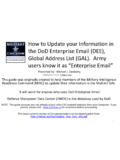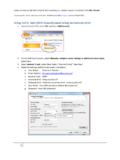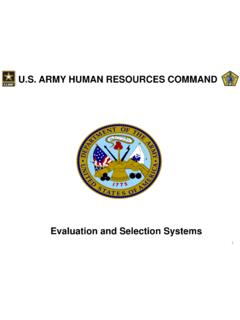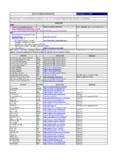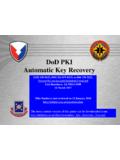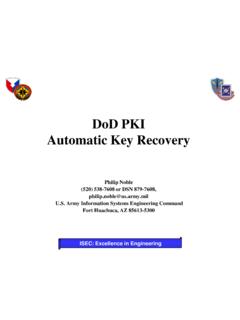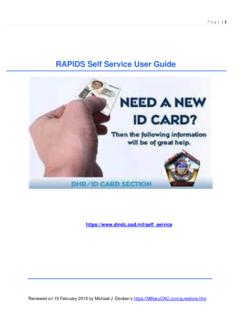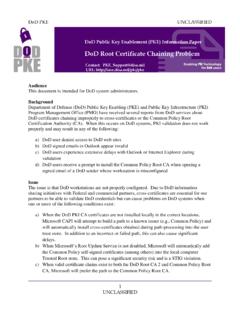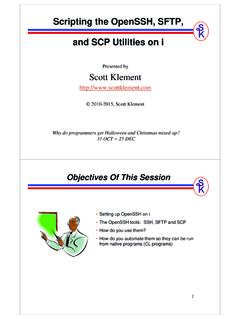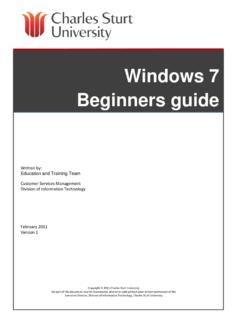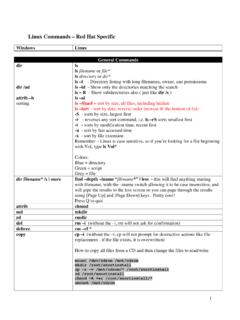Transcription of ARMY PASSWORD STANDARDS - Common Access …
1 04-IA-O-0001 Issuance date: 15 DEC 04 Update: 1 MAY 08 army PASSWORD STANDARDS Version 11. Overview: A. Since 31 JUL 06, Access to all army networks was mandated to be via the Common Access Card (CAC) only. Passwords remain an important aspect of computer security to achieve authenticated Access control at the workstation or host level for authenticating Access to army resources until CAC is fully implemented. As such, all users, employees, including contractors and vendors, with accounts on, or Access to army Information Systems (ISs), are responsible for taking the appropriate steps to generate and secure their credentials.
2 B. Passwords are used for a variety of purposes. Since very few systems have support for one-time tokens ( , dynamic passwords which are only used once), users must use strong passwords in their official and personal accounts. C. Only randomly generated passwords, generated by a special purpose generator that draws from the largest ASCII character sets available, can keep a step ahead of PASSWORD cracking programs and should be routinely used when passwords are required. References: A. JTF-GNO CTO 07-015, Public Key Infrastructure (PKI) Implementation, Phase 2 (U/FOUO) DTD 11 DEC 07 B. AR 25-2; Information Assurance (URL LINK) C. How to Enable NTLM 2 Authentication Microsoft D. How to Disable LM Authentication on Windows NT - Microsoft E. How to Prevent Windows from Storing a LAN Manager Hash of Your PASSWORD in Active Directory and Local SAM Databases.
3 Microsoft F. Top 20 Critical Internet Vulnerabilities SANS G. System Administrator Standard Operating Procedures (SOP) BlackBerry Devices with Internal Bluetooth Capability Related BBPs: None 2. Point(s) of Contact (POC): NETCOM ESTA / OIA&C Greg Weaver (CTR SPT) 703-602-7421; DSN 332 Timothy Hiligh (CTR SPT) 703-602-7509; DSN 332 Mr. Gary Robison 703-602-7395; DSN 332 3. Description of Required Resources: The System Administrator or Network Administrator (SA/NA) must be certified on the existing IA approved product list and the utilization of an approved scanning application to verify compliance. 4. Administrative Requirements: A. Authenticate user Access to all systems with a minimum of a USERID and an authenticator. An authenticator may be something the user knows ( PASSWORD ), something the user possesses (token), or a physical characteristic (biometric).
4 The most Common authenticator is a PASSWORD . 04-IA-O-0001 Issuance date: 15 DEC 04 Update: 1 MAY 08 army PASSWORD STANDARDS Version 2B. Changing passwords more frequently is authorized and encouraged, for example every 30 days, if PASSWORD generation software or devices are utilized that meet configuration STANDARDS or use one-time or time-based credentials. C. SA/NA will provide advance user warning and notification that expiration of their PASSWORD is approaching to assist in choosing good passwords. Preference is a 10-14 day notification window. D. The use of one-time passwords is authorized. E. The use of time-based tokens is authorized. F.
5 User accounts that have system-level privileges through group membership accounts or programs such as "sudo" must have a unique PASSWORD from all other accounts held by that user. G. Remove, change, or disable all default, system, factory installed, guest, function-key embedded, or maintenance accounts and passwords. When SNMP is used, the community strings will be changed from the standard defaults such as "public," "private", and "system", and must be different from the passwords used to log in interactively. A keyed hash must be used where available ( , SNMPv2). H. The use of PASSWORD generating software or devices is authorized as a memory aid (mnemonic) when it randomly generates and enforces PASSWORD length, configuration, and expiration requirements; protects from unauthorized disclosure through authentication or Access controls; and presents a minimal or acceptable risk level in its use.
6 The use of PASSWORD management applications or devices should allow users the ability to scroll through offered selections to choose an acceptable mnemonic to remember. I. TACTICAL EXCEPTION NOTE: Consistent with the processes outlined in AR 25-2, the expiration change interval may be extended beyond the requirement for root/secman passwords on tactical systems fielded or being fielded to areas of conflict. The Designated Approving Authority (DAA) will ensure that a risk analysis is performed to address the need to extend the PASSWORD change interval for these types of accounts. The DAA will then ensure suitable countermeasures are developed and that the risk analysis, along with the required countermeasures, is documented in accreditation documentation and in the approval memorandum signed by the DAA. This only will be done in situations where security, operational effectiveness, and/or troop safety is enhanced by not providing unit level administrators Access to these privileged accounts in order to maintain the integrity of the deployed or deploying tactical systems functional software baseline.
7 Only tactical system DAAs recognized in writing by the army CIO/G-6 may approve these case-by-case deviations. Consistent with the provisions for tactical systems in both AR 25-2 and DoDI , allowances are made for the tactical environment in order to reduce the risk to combat crews from denial of service/lock out situations or other impractical implementations that affect troop safety with a limited amount of risk. 5. Description: A. army PASSWORD Requirements (1) All system or system-level passwords and privileged-level accounts ( , root, enable, admin, administration accounts, etc.) will be a minimum of 15-character case-sensitive PASSWORD changed every 60 days (IAW JTF-GNO CTO). 04-IA-O-0001 Issuance date: 15 DEC 04 Update: 1 MAY 08 army PASSWORD STANDARDS Version 3(2) All user-level, user-generated passwords ( , email, web, desktop computer, etc.)
8 Will change to a 14-character (or greater) case-sensitive PASSWORD changed every 60 days. (3) PASSWORD history will be set to a minimum of 10. (4) Set the Observation Window for Account lockout settings to no more than 60 minutes. Set the LockoutDuration setting (also known in Group Policy as the Account lockout duration setting) to 0 and the LockoutThreshold setting (also known in Group Policy as the Account lockout threshold setting) to 3. This allows no more than two unsuccessful logon attempts within a 60 minute period and requires a system administrator to unlock the account. (5) When supported, enable that system capability to notify the user of last successful and unsuccessful logon time and date. Users will notify administrative and security personnel when discrepancies are identified. (6) The PASSWORD will be a mix of uppercase letters, lowercase letters, numbers, and special characters with a minimum of characters as follows: a.
9 Contains at least 2 uppercase characters: A, B, C etc. b. Contains at least 2 lowercase characters: a, b, c, etc. c. Contains at least 2 numbers: 1,2,3,4,5,6,7,8,9,0 d. Contains at least 2 special characters, ! @ # $ % ^ & * ( ) _ + | ~ - = \ ` { } [ ] : " ; ' < > ? , . / (7) Passwords will not have the following characteristics: a. Is a word found in any dictionary, thesaurus, or list (English or foreign) b. Is any Common usage word or reference such as: (I) Names of family, pets, friends, co-workers, fantasy characters, etc. (II) Computer terms and names, commands, sites, companies, hardware, software. (III) Common words such as; "sanjose", "sanfran" or other derivative. (IV) Birthdays, addresses, phone numbers, or other personal information. (V) Word or number patterns like; aaabbb, qwerty, mypassword, abcde12345.
10 (VI) Any of the above spelled backwards. (VII) Any of the above preceded or followed by a digit ( , secret1, 1secret). (VIII) Social security numbers (SSNs). (IX) USERID (X) Military slang, acronyms, or descriptors or call signs. (XI) System identification. (8) The use of eight character passwords are authorized when: (I) The PASSWORD generated is a purely random-generated authenticator from the complete alpha/numeric and special character sets and no user-configured passwords can replace, be generated, or accepted in lieu of the generated PASSWORD . (For example: Credentialing system issues randomly generated authenticator AND enforce use of that authenticator to network resources.) Or: 04-IA-O-0001 Issuance date: 15 DEC 04 Update: 1 MAY 08 army PASSWORD STANDARDS Version 4 (II) Access to private applications is conducted over an approved 128-bit encrypted session between systems, and the application does not enforce local user Access credentialing to a local network resources.
